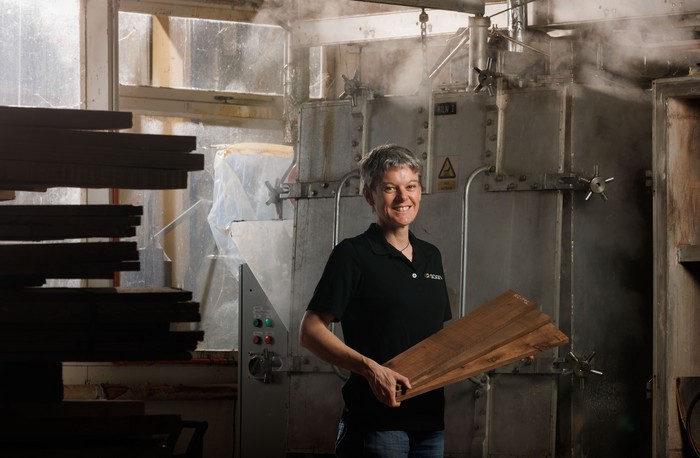Scientist profile: Rosie Sargent

Working for the love of wood
Rosie Sargent loves wood. It’s an incredible complex material, she says, that performs well and shouldn’t be underestimated.
It’s that love that gets the Bioeconomy Science Institute senior technologist up in the mornings. Rosie’s work centres around processing wood, mainly around wood drying and modification. “My work is really varied,” she says. “On any given day I could be reading literature and figuring out logistics for a processing trial, analysing data, or driving the forklift and stacking timber.”
Currently she’s helping some commercial clients scale-up a new process from the lab scale to the sawmill. “It’s exciting. We’ve been helping them find the best processing conditions and monitor the process to make sure it’s working the way they want.
Rosie and her team are also commissioning a new control system for kilns in the timber drying lab. “This will give us a bit more functionality and bring us up to date with the control system used in most New Zealand and Australian sawmills. Part of my job is to help sawmills better manage their drying processes, so being familiar with the latest control software is an important part of that.”
Background
She has an engineering degree (chemical and process engineering) from Canterbury University. This field, she says, was a natural fit for her. “I was always really interested in science, but also very practical. My current role has a really good mix of the curiosity and discovery of science, plus the practical side working with equipment and machinery.”
Rosie started as a scientist with Scion (now part of the Bioeconomy Science Institute) 25 years ago, when it was the Forestry Research Institute. Her work, she says, has always been ‘a bit fluid’, spread across a range of projects and areas. She’s led various projects for nine years and became a senior technologist in 2020.
She also worked over the 2020/21 summer at Carter Holt Harvey Tissue (now Essity) in Kawerau, helping improve the operation of the pulp mill. “I really like working with equipment, especially at pilot- and industrial-scale,” she says.
Working with mills has provided some memorable career moments for Rosie. “Setting up and running a mill trial is a real achievement,” she says.
“You have a process that works on a smaller scale, then you are asking a whole mill full of people to stop what they’re doing and try your new process. It takes a huge amount of planning, but seeing something new working on an industrial scale is really exciting.”
Outside the lab
Rosie grew up in Nelson. She moved to Canterbury for university before coming to the Bay of Plenty. The best thing about Rotorua, she says, is its location. “It’s central to a lot of outdoor activities and there’s so much to do close to town – lakes, bushwalking and mountain biking.”
“I really enjoy being active in the outdoors – mountain biking, tramping – the top of the South Island and Mt Taranaki are favourite spots, though I don’t get there as often as I’d like – and a bit of trail running, largelyon the trails around Lake Okataina.
She also enjoys making things. “I have three sewing machines, plus a workshop with metalworking and basic woodworking tools. I do enjoy gardening, but it gets neglected at the bottom of the list of hobbies. Mostly I grow hops, which I brew into one or two batches of IPA each year to enjoy with friends.”
Rosie and her partner Bruce also love going off on adventures. “We’ve got no kids, pets or houseplants,” she jokes. They’ve done some climbing on Ruapehu and Tongariro this past winter, and Rosie walked the Larapinta trail in the Northern Territory with a friend in July.
“Finding time for all my hobbies is an ongoing challenge,” she laughs.
The future
Back on the work front, the year ahead will bring plenty of challenges, too, for Rosie and her team. “We’re really keen to start a project processing redwood timber,” she says. “More and more redwood is being grown in New Zealand, and in 15-20 years there’ll be enough being harvested to justify a purpose-built redwood sawmill.
“For this to happen, we need to start learning more about what products we can make from different parts of the redwood tree, and to understand how best to process them.”
Rosie recently ran a two-day course on timber drying, for staff from Windsor Engineering and Automation & Electronics (A&E). The feedback was excellent, and she hopes to run further courses in future. She enjoys sharing her knowledge and passion for wood and says there’s always lots of interest in her work.
“People love the look and feel of wood. I sometimes have people wanting to look at or touch my research samples while I’m working with them. I’m not sure that would happen if I was working with concrete or steel.”
